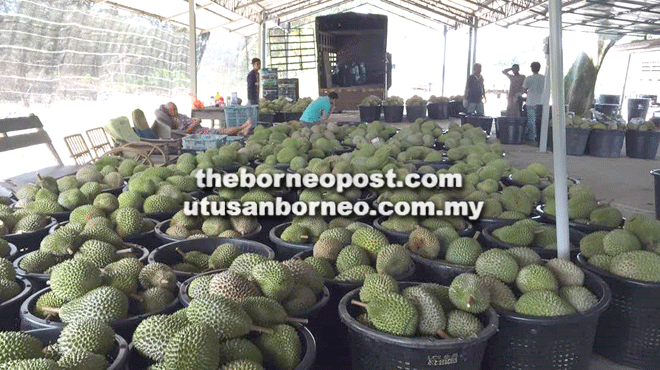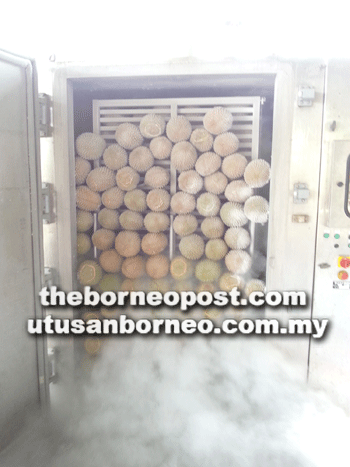BINTULU: Do you know the most significant difference between Malaysian durian and Thai durian?
According to Associate Professor Dr Phebe Ding of Postharvest Physiology, Faculty of Agriculture and Food Sciences, Universiti Putra Malaysia Bintulu Campus, Malaysian fresh durian fruit is only harvested after the fruit has reached its full ripening stage.

She said the abscission zone of a fully ripened durian fruit will weaken and cause the peduncle of fruit to break apart at the abscission zone.
Thus, the fully ripened fruit falls off from its peduncle/stem with strong aroma.
“Unfortunately, this fully ripened fruit has very short postharvest life and thus the fresh fruit cannot be distributed far.
“Furthermore, the strong and intense aroma of durian fruit hinders it from air shipment in fresh form.
“A special packing is needed to ship durian through air. Thus, Malaysian fresh durian has very limited market as compared to Thai durian,” she told The Borneo Post yesterday.
Dr Ding pointed out that ever since fresh Malaysian durian was introduced to Chinese tourists, they fall in love with it.

Furthermore, in China, according to Dr Huang Huikang (former People’s Republic of China ambassador to Malaysia), durians were promoted as fruit with revitalising values and that it was said ‘one durian fruit was equivalent to three hens’.
“Aiming the 1.3 billion Chinese population, thus our growers plant durian in large scale. It is expected very soon durians, especially clone D197 (Raja Kunyit) or more well known as Mao Shan Wang by Chinese (or Musang King by Malaysian), will flood our market.
“With the small population of 32 million, it is impossible for Malaysians to consume all the durian fruits. Strategies are needed to market the fruit,” she added.
The Musang King, which is famous for its golden yellow flesh and bittersweet taste, is a favourite among Chinese tourists.
However, Dr Ding said due to quarantine requirements in international trading, authorities in China and other importing countries only allow de-husked durian fruits to enter their country.
She said durian lovers prefer to taste the fruit fresh from the husk, instead of the ice-packed versions.
“So, how to market the whole fresh durian fruit? Currently, entrepreneurs in Malaysia are using cryogenic freezing technology to retain the freshness of whole durian.
“Globally, it is not a new technology to preserve fresh agricultural produces, however, it is relatively new to our fresh fruit industry and public,” Dr Ding explained.

Since 1755, freezing has been used as a method of preservation. By the late 1800s, freezing was used widely to preserve meat, fish and butter.
Later, fresh fruits were one of the most important commodities to be frozen during the peak harvesting season. It was recorded that the commercial freezing of small fruits and berries first began around 1905 in the United States.
Dr Ding said refrigeration is a part of the freezing process and according to the second law of thermodynamics, heat only flows from higher to lower temperatures.
“Therefore, in order to raise the heat from a lower to a higher temperature level, expenditure of work is needed, by absorbing heat from surroundings.
“As such, refrigerant is needed to absorb heat from surroundings to evaporate into a gas and leaving the air cooler,” she said.
There are several refrigerants available for refrigeration systems. The selection of a proper refrigerant is based on physical, thermodynamic, chemical properties of the fluid and environmental considerations.
There are a few types of freezing systems available for freezing fruits and vegetables.
“Cryogenic freezing is a relatively new method of freezing in which the fruits and vegetables are exposed to an atmosphere below -60°C through direct contact with liquefied gases such as nitrogen or carbon dioxide.
“These two gases are common in our atmospheric air with 78 per cent nitrogen and 0.04 per cent carbon dioxide,” she said.
She added since early 1960s, Europeans have been using liquid nitrogen or carbon dioxide as an expendable refrigerant in their cryogenic freezing system to process meat, poultry, seafood, fruits, vegetables, pasta, dairy products and baked goods.
Dr Ding said presently, local entrepreneurs have found out the whole fresh durian fruit can be frozen by exposing to liquid nitrogen at -90°C for one hour and the frozen fruit can be stored at -18°C for two years without losing much of its original flavour, taste, flesh colour and texture.
She added another advantage of cryogenic freezing is the ‘disappearance’ of durian fruit’ aroma after freezing.
The unique aroma of durian will resume and the fruit is ready to be eaten after four and five hours of defrosting, she said.
As a tropical crop, the production of durian is often affected by weather. With the global warming, it is difficult to predict the production volume of durian fruits.
“Since the commodity price is depending on its supply and demand, cryogenic freezing technology enables producers to stock the fruits when there is surplus supply.
“Growers, who lack bargaining power in commodity price, could now benefit from this technology. On top of this, the frozen fresh durian fruit is much easier to be handled than the unfrozen one,” said Dr Ding.
As such, the fruits can be marketed and distributed farther, and more durian lovers could enjoy the King of Fruits whenever and wherever they wish.
Hopefully, she added, the application of cryogenic freezing technology would enable the 800,000 durian entrepreneurs and growers in the country to stay competitive and sustainable in fresh durian fruit markets.
More info : http://www.theborneopost.com/2018/09/26/cryogenic-freezing-technology-twisting-msian-durians-fate/
Tarikh Input: 02/10/2018 | Kemaskini: 02/10/2018 | lanz
PERKONGSIAN MEDIA


































